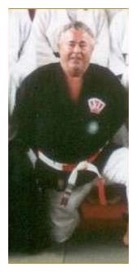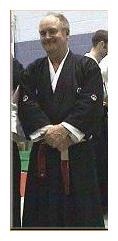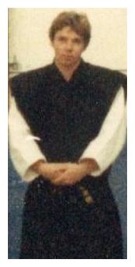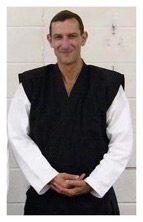
Our History - Shorinji Kan Jiu Jitsu
The origins of our style are hard to trace. Matthew Komp Shihan (click for more info) began his martial arts study in the 1940's when he took up wrestling. After joining the police force in Germany, he began to study judo and jiu jitsu as part of his police self-defence training. He also studied karate, aikido and taekwon-do. He has had a number of instructors from Japan, Germany and Korea. From these influences, Matthew Komp formed his style of jiu jitsu which he took to Australia in the 1950's, where he founded a school in Footscray, near Melbourne Komp Shihan continued to teach until his passing, July 2017.



Brief Ancient History
Many fighting systems developed in Japan during its feudal era - the use of the lance, sword, staff, archery, hand-to-hand combat, and many more. Systems of unarmed combat became known as jiu jitsu (also spelled ju jitsu, ju-jitsu, jujitsu or jujutsu, ju jutsu, ju-jutsu), also referred to as taijutsu and yawara.
The birth of jiu jitsu probably coincided with the origins of the Samurai class in 792 AD. The army at that time consisted of foot soldiers armed with spears. Officers were recruited from the young sons of the high families and schooled in archery, swordsmanship, and unarmed combat. The Emperor Kammu built the Butokuden (Hall of the Virtues of War) as a formal school for these officers who became known as Samurai.
Jiu jitsu techniques involved throwing, locking, striking, choking, and pinning, and the defences to these and all manner of weapons. Because these techniques were designed for combatants wearing armour, the large leaping and kicking movements found in many other arts were not used in jiu jitsu. Read more…
During the 12th century, the Emperor was overthrown and approximately 400 years of civil war followed. During this time, jiu jitsu was continually tested and refined on the battlefield. Although jiu jitsu techniques had been used for centuries, it was during the Edo period (1603 - 1868) that jiu jitsu developed into a systematic art taught by numbers of masters, with over 700 different schools at the height of its popularity.
However, in 1873, the government brought the rigid social structure to an end and prohibited the Samurai from wearing swords in public. Many Samurai resisted this legislation and although they were eventually suppressed, their resistance seriously damaged the reputation of the martial arts. This, together with sweeping social changes in Japan, led to a vast decline in the popularity of jiu jitsu, although the recent offshoots of Judo and Aikido (not associated with the Samurai, however) began to gain in popularity.
After World War II, the occupation forces prohibited the practice of the martial arts and this ban was not revoked until 1951. Many jiu jitsu practitioners left Japan at this time and began introducing their art to the western world.
Brief Ancient History
Many fighting systems developed in Japan during its feudal era - the use of the lance, sword, staff, archery, hand-to-hand combat, and many more. Systems of unarmed combat became known as jiu jitsu (also spelled ju jitsu, ju-jitsu, jujitsu or jujutsu, ju jutsu, ju-jutsu), also referred to as taijutsu and yawara.
The birth of jiu jitsu probably coincided with the origins of the Samurai class in 792 AD. The army at that time consisted of foot soldiers armed with spears. Officers were recruited from the young sons of the high families and schooled in archery, swordsmanship, and unarmed combat. The Emperor Kammu built the Butokuden (Hall of the Virtues of War) as a formal school for these officers who became known as Samurai.
Jiu jitsu techniques involved throwing, locking, striking, choking, and pinning, and the defences to these and all manner of weapons. Because these techniques were designed for combatants wearing armour, the large leaping and kicking movements found in many other arts were not used in jiu jitsu. Read more…
During the 12th century, the Emperor was overthrown and approximately 400 years of civil war followed. During this time, jiu jitsu was continually tested and refined on the battlefield. Although jiu jitsu techniques had been used for centuries, it was during the Edo period (1603 - 1868) that jiu jitsu developed into a systematic art taught by numbers of masters, with over 700 different schools at the height of its popularity.
However, in 1873, the government brought the rigid social structure to an end and prohibited the Samurai from wearing swords in public. Many Samurai resisted this legislation and although they were eventually suppressed, their resistance seriously damaged the reputation of the martial arts. This, together with sweeping social changes in Japan, led to a vast decline in the popularity of jiu jitsu, although the recent offshoots of Judo and Aikido (not associated with the Samurai, however) began to gain in popularity.
After World War II, the occupation forces prohibited the practice of the martial arts and this ban was not revoked until 1951. Many jiu jitsu practitioners left Japan at this time and began introducing their art to the western world.
Matthew Komp Shihan
Matthew Komp Shihan began his martial arts study in the 1940's when he took up wrestling. After joining the police force in Germany, he began to study judo and jiu jitsu as part of his police self-defence training. He would become a successful judo competitor and referee, and a full-time jiu jitsu instructor. He also studied karate, aikido and taekwon-do. He has had a number of instructors from Japan, Germany and Korea. These influences no doubt had a significant influence on his style of jiu jitsu.
In the 1950's, Matthew emigrated to Australia, initially on a 2-year contract, to teach unarmed combat to the police. He founded a judo and jiu jitsu club in Footscray, near Melbourne.
Although around 80 years old, Matthew continues to teach jiu jitsu at his club and conducts seminars in Germany and the UK.
Andy Dobie Sensei
Having first studied judo as a youth, Andy Dobie Sensei began his study of jiu jitsu in 1985 at Plymouth Polytechnic in Plymouth, England, with the National Samurai Jiu Jitsu Association (later renamed The Jitsu Foundation). In 1988 he became the club instructor of the University of Plymouth Samurai Jiu Jitsu Club, a position he held until 1992.
In August 1993 he moved to Peterborough, Ontario, Canada and established the first Jitsu Canada club, at Trent University, then later opened the Peterborough YMCA club in September 1998.
Andy Dobie Sensei is the president and head instructor of Jitsu Canada.
Brian Graham Shihan (1934-2005)
Brian Graham Shihan was the founding father of The Jiu Jitsu Foundation and Head of Style for Shorinji Kan Jiu Jitsu.
Born in Keighley, West Yorkshire, he learned his jiu jitsu skills in Australia under Matthew Komp Shihan in the 1960's. When he returned to the UK, Brian opened the first Samurai Jiu Jitsu club in Keighley.
Brian's technical ability and enthusiasm produced a number of instructors - most notably the late Peter Farrar. Under the leadership of Brian and Peter, the style spread rapidly throughout the UK and other countries.
Brian will be remembered for his straight talking style of teaching, his enthusiasm and his incredible ability. He was a supreme exponent of jiu jitsu and motivator of instructors who strove to attain his level of skill. His down to earth approach to life and his unique sense of humour will be sorely missed.
Brian was inspirational in the founding of Jitsu Canada, and travelled to Canada on a number of occasions providing the benefit of his vast martial arts knowledge and experience. As he has done for the past fifty years, Brian was actively teaching jiu jitsu up until his recent brief illness.
His loss is deeply felt by his wife, children and grandchildren (on whom he doted), and the thousands of students in The Jiu Jitsu Foundation throughout the world who's lives have been touched by him.
Peter Farrar Sensei (1960-1997)
Peter Farrar Sensei was one of the founders of The Jiu Jitsu Foundation. Born in Keighley, West Yorkshire, he began his study of jiu jitsu in 1969 at the age of nine, under the instruction of Brian Graham Shihan. In 1979, Peter moved to Plymouth and opened the Plymouth Polytechnic Jiu Jitsu Club. Peter had a clear vision and goal of founding an association and expanding the style across the country.
Peter's ability, drive and enthusiasm produced a number of instructors who quickly spread the style to a number of UK universities. From these beginnings, the style spread rapidly to other universities and to non-university based venues throughout the UK, and then other countries.
Peter had a significant impact on the style. The emphasis of his jiu jitsu differed from his teacher's, and Peter emphasized the aiki aspects of the style.
However, his greatest impact was on the development of the teaching style and training methods which are fundamental to our style. Peter designed and wrote the initial versions of our instructor training program and had a dramatic impact upon the way we now teach jiu jitsu.
Peter is credited, along with Brian Graham, as being a co-founder of The Jiu Jitsu Foundation and he directly taught the current leaders of The Jiu Jitsu Foundation. It is without doubt that his drive and enthusiasm played a key role in the expansion of the style across the UK.
Farrar Sensei made a couple of visits to Jitsu Canada, including presiding over the first Shorinji Kan grading examination held in Canada, December 1993. Sadly, Peter died of cancer in 1997 at the age of thirty-seven.
